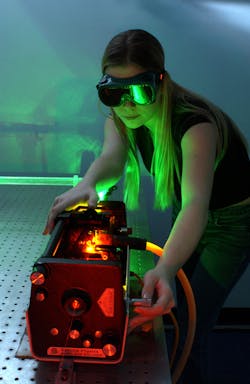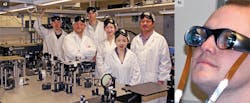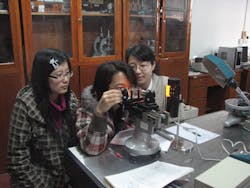
A high-school graduate who has decided to pursue a career in optics/photonics has made a good choice indeed, considering that optics/photonics professionals command annual median salaries of $80,000 based on a recent SPIE (Washington, DC) salary survey at http://spie.org/salary. But how does one actually begin a career in photonics?
Many say that the secret to a successful career in optics/photonics is knowing which educational institution to attend. But beyond obtaining a university degree at one of the top optics/photonics institutions like CREOL (College of Optics & Photonics at the University of Central Florida) or École Polytechnique, there are also myriad lesser-known colleges and universities that provide full undergraduate and graduate optics/photonics degree programs, as well as much-needed optics technician programs (see "Technician opportunities" for more information on this area of further education).
This article highlights the optics/photonics educational programs at several institutions worldwide and offers some useful resources for the aspiring optics/photonics student, with an eye toward the industrial and academic opportunities available after graduation.
A global resource
With more than 350 international listings and nearly 150 in the United States alone, the Optics and Photonics Education Directory at www.opticseducation.org—a joint public service effort by SPIE (Bellingham, WA) and the Optical Society (OSA; Washington, DC)—is by far the most comprehensive global listing of degree programs in optics and photonics.
Scrolling through the various optics/photonics educational listings, I was surprised to learn that even the biggest optics/photonics programs in the United States and Europe consist of only 200–300 students, with most averaging about 50 students. An exception is China, for which several institutions enroll between 1500–2000 optics students.
The US cream of the crop
Educating more students in optics than any other university in the United States, the University of Arizona (U of A) College of Optical Sciences (OSC; Tucson, AZ) has 138 undergraduate and 304 graduate students that can benefit from 90 specialized photonics courses—with 20 different undergraduate and 36 different graduate courses offered each semester. The OSC degree program also offers two distance learning options, allowing students to complete courses by video or satellite and even transfer six or seven units from other institutions.
The OSC campus houses internationally leading facilities in large optics fabrication and engineering, quantum optics, and photonics, and is closely coupled with the medical school for biomedical optics. Students with an average 1232 SAT score, 26.9 ACT score, and 3.7 GPA that are admitted into the U of A College of Engineering can pursue an OSC degree in their freshman or sophomore year (and must maintain a 2.5 GPA to graduate).
"Our undergraduate students receive a broad education in the fundamentals of geometrical, physical, quantum, and mathematical optics," says Thomas L. Koch, OSC dean and professor of optical sciences. "Our very active research program enables students to do master's degree and doctoral research in a wide variety of subfields, ranging from basic optical physics to applied optical engineering and photonics; most of our seniors graduate with academic research or industrial internship experience on their resumés."
Tuition for the 58% resident OSC population averages $5000 per semester, while the 41% non-resident (19% international) student population pays $13,000 per semester. Fortunately, as with every other public and private university, student aid packages and science-based scholarships are available that can reduce these fees dramatically.
And when it comes time for graduates to find a job, they are greatly assisted by the OSC Industrial Affiliates (IA) program, which aims to match the skills of graduates with the job skills needed by companies in the photonics industry through workshops and career fairs/recruiting events (see Fig. 1).Although undergraduate tuition is $41,800, every PhD student in the Institute of Optics receives a tuition waiver; through financial aid even undergraduates may receive a tuition waiver and stipend that covers as much as two-thirds of the annual fees. And unlike many institutions, you don't need a master's degree to enter the PhD program.
"Of the 33 people for whom I was PhD advisor over a 30-year period, thirteen have started their own business or are company CEOs," says Duncan Moore, vice provost for entrepreneurship, a professor in numerous disciplines, and former dean of engineering and applied sciences from 1995-1997, all at the University of Rochester. "The Institute of Optics has a very strong entrepreneurship component that encourages graduates to think beyond fundamental math and science, and has obviously been successful for placing our graduates not only in hard-core engineering positions, but also at high-level management and marketing positions within the photonics industry."
Despite the fact that nearly 54,000 Rochester-area Kodak jobs alone have been lost in the past 30 years, the Rochester community has gained a net 90,000 jobs over the same period, says Moore in his New York Times op-ed piece. "The high-skilled workers [Kodak] let go over the years created a valuable labor pool for start-up companies, particularly in optics and photonics," says Moore. "Over the last five years [the University of Rochester] has received more than $1.9 billion in research money, most of it from the federal government, which has in turn fueled local growth beyond the campus gates."
As of Jan. 1, 2012, the University of Rochester's Institute of Optics has a new director, Xi-Cheng Zhang. "The director's position provides me the platform to work together with the best team to make a global impact in optics and photonics," says Zhang. "It's my vision that Rochester's Institute of Optics will continue to excel in research and education in a challenging climate."
Top-notch in Europe and Asia
"Scotland is a great place to study photonics," says Derryck T. Reid, professor in the Ultrafast Optics Group and director of the EPSRC Industrial Doctorate Centre in Optics and Photonics Technologies within the School of Engineering and Physical Sciences at Heriot-Watt University (Edinburgh, Scotland). "The central belt of Scotland is home to a considerable number of photonic startup companies, justifying a comparison with Silicon Valley, but in photonics rather than electronics. Roughly half of the UK's photonics research output is generated by a handful of Scottish universities, in which Heriot-Watt is perhaps the biggest contributor with photonics research that spans the spectrum between industrial requirements and development of new R&D paradigms in sensing and quantum information processing."
"Heriot-Watt, jointly with St. Andrews University, operates one of the world's longest running master's courses in photonics," says Reid. "The 'MSc Photonics and Optoelectronic Devices' goes back to 1982 and has graduated several hundred students over this period. And our newly formed Institute of Photonics and Quantum Sciences has around 70 PhD students, with another 70 students currently enrolled in the 'Engineering Doctorate' (EngD) program, for which a company proposes and hosts the research project." Reid says that EngD students spend four years completing the course, with one year spent on a combination of technical and business modules from Edinburgh Business School's MBA program and the remaining three years spent at the company's site working on the research project.
Resident EU/UK tuition at Heriot-Watt is approximately $6900 per year, while non-resident tuition runs about $21,900. Of the roughly 7000 students at Heriot-Watt, nearly a third are from countries outside the UK, adding a real international flavor to the Scottish community.
Heriot-Watt careers advisor Keith Kilgore estimates that 90% of Heriot-Watt's optics/photonics students are fully employed within 6 months of graduation, and Reid notes that the practical and mathematical skills needed for photonics and lasers are highly transferrable to a variety of careers. "The photonics and optics sector can accommodate both the aspirations of graduates seeking an industrial career—such as applications of lasers in machining or sensing—and those who are attracted by the fundamental science," adds Reid. "The laser was 50 years old in 2010, and is now ubiquitous in all walks of life, and it's notable how many Nobel Prizes have been fundamentally connected to photonics research."
Nearly 5000 miles from Scotland, Tianjin University was the first university in China, established in 1895 and then named Peiyang University. The College of Precision Instrument & Opto-electronics Engineering offers five bachelor's degrees, of which three are directly related to optics/photonics: photoelectric information engineering, optoelectronics, and an optoelectronic technology science degree in cooperation with Nanking University. The bachelor's degree programs alone have more than 700 students, while the six postgraduate disciplines for optics/photonics have 300 master's-level students and 50 PhD candidates.
"Our optoelectronics college at Tianjin University has about 200 teachers including 60 professors and 58 associate professors," says Huaiyu Cai, professor and associate dean of the College of Precision Instrument & Opto-electronics Engineering at Tianjin University (see Fig. 3). "In addition to our four departments, we also have a state key laboratory of Precision Measuring Technology and a ministry key laboratory of Opto-electronics Information Technical Science, as well as many research centers including the Modern Optics Research Institute, Opto-electronics Research Center, Illumination Technology Research Institute, Laser and Opto-electronics Technology Research Institute, and the Photobiology Research Institute." Cai says that resident tuition runs less than $900 per year and overseas students pay just under $2700 annually. "Overseas students are welcome and we hope more students choose Tianjin University in the future," she adds.Where your career can lead
While no one can guarantee a Nobel Prize will result from a career in photonics, Heriot-Watt's Derryck Reid is absolutely correct that a career in optics/photonics can focus on R&D or engineering, broaden into sales/marketing or management, or possibly revert to a teaching career if there is a strong desire to return to the academic world.
Edmund Optics (Barrington, NJ) is actively involved in the industrial affiliates programs at the University of Arizona, University of Rochester, and CREOL; supports optics/photonics education through such activities as their Higher Education Grant Program (www.edmundoptics.com/university); and actively recruits students from academia.
"Our engineering and technical staff comes with a wide variety of degrees and backgrounds, and from institutions as diverse as Yale University [New Haven, CT] and Carthage College [Kenosha, WI]," says Kirsten Bjork-Jones, director of global marketing communications at Edmund Optics (Barrington, NJ). "We are really looking for candidates with that 'go-to' quality which comes across in face-to-face meetings or creative marketing of themselves on social media."
Edmund Optics even offers an Engineering Leadership Program—a two year-rotational program that helps new engineering talent transition from academia to the business world. "In fact, one of our engineering leaders is on assignment at our Akita, Japan facility assisting with running our manufacturing operations," says Bjork-Jones. "Not only is he growing his career, but he's having the time of his life exploring a world of possibilities."
Technician opportunities
"A successful technical workforce is a three-legged stool of scientists, engineers, and technicians, and all three 'legs' play a crucial role," says Daniel M. Hull, director and principal investigator of The National Center for Optics and Photonics Education or OP-TEC (www.op-tec.org; Waco, TX), a National Science Foundation (NSF) Center of Excellence with a mission to increase the supply of well-educated photonics technicians by building and strengthening the capacity and quality of photonics education in US two-year colleges. "Based on an OP-TEC survey of more than 4000 US photonics companies, every year through 2013 we need to add 1200 photonics technicians to our workforce; unfortunately, our 31 partner colleges are only producing about 250 graduates per year," says Hull. "There is a lot of work to do."
In addition to providing technical assistance in new program planning and courses for training new photonics faculty, OP-TEC designs and develops educational materials for photonics technician education, as well as dual-credit courses for high schools to build science, technology, engineering, and mathematics programs that prepare students to enroll in AAS degree photonics programs after high school graduation. Hull says that many students pursuing technician careers use "just in time" video tutorials to improve math skills so that they can complete a technical degree. "Last year, one of our partner colleges, Indian Hills CC [IA] graduated 19 photonics technicians who received 95 different job offers with salaries ranging from $45,000 to $60,000," says Hull. "Skilled people who also understand the scientific principles of lasers and optics can put equipment together, make it work, and keep it working; they're indispensable and are in great demand."
"The photonics industry as a whole is rapidly growing. Optics are used everywhere from smart phones to LASIK surgery," says Mike Mandina, president of Optimax Systems (Ontario, NY) and one of the founding fathers of the Finger Lakes Advanced Manufacturers' Enterprise (FAME) (www.nyfame.org), an organization in Western New York dedicated to cultivating the pipeline of skilled technology workers through educational outreach and by partnering with community colleges and local companies. "With this rapid growth and advancement in technology it's important to have an optics educated workforce to support it. In higher education the majors and classes that are optics-specific are growing and as a company we are working to support this initiative, but we still need more graduates who are skilled engineers and technicians with optical experience who want to make a career in the industry as it continues to grow."
Optimax currently has more than 100 opticians and 170 employees with plans to hire 30 more employees this year. Out of these current employees a significant number are local community college and University of Rochester graduates.
To further assist curious students, OP-TEC and other organizations have posted a number of photonics-education-oriented videos on YouTube; simply search YouTube using the words "photonics careers" or "photonics education."
About the Author

Gail Overton
Senior Editor (2004-2020)
Gail has more than 30 years of engineering, marketing, product management, and editorial experience in the photonics and optical communications industry. Before joining the staff at Laser Focus World in 2004, she held many product management and product marketing roles in the fiber-optics industry, most notably at Hughes (El Segundo, CA), GTE Labs (Waltham, MA), Corning (Corning, NY), Photon Kinetics (Beaverton, OR), and Newport Corporation (Irvine, CA). During her marketing career, Gail published articles in WDM Solutions and Sensors magazine and traveled internationally to conduct product and sales training. Gail received her BS degree in physics, with an emphasis in optics, from San Diego State University in San Diego, CA in May 1986.


